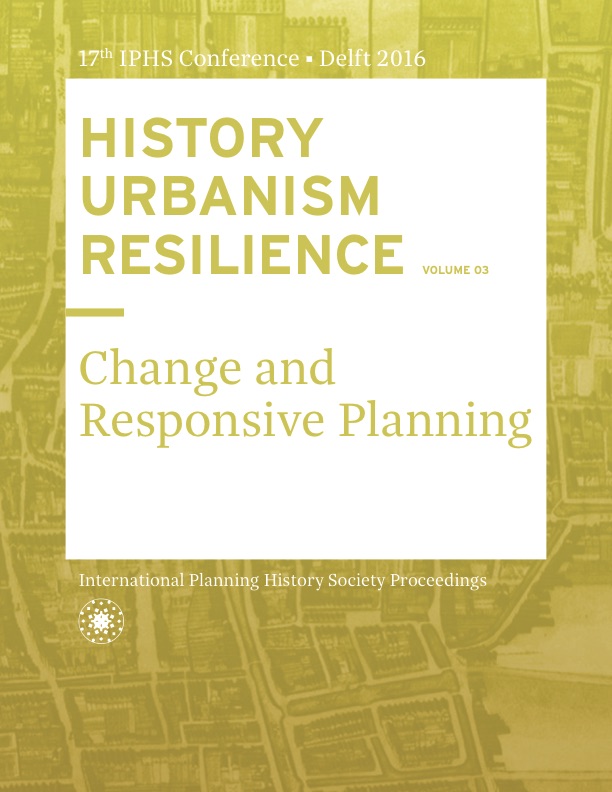The industrial and commercial harbours of Strasbourg and Kehl : wasteland territories in transition towards a sustainable cross-border metropolitan core
DOI:
https://doi.org/10.7480/iphs.2016.3.1255Abstract
The current location of the commercial and industrial harbour of Strasbourg dates from the late nineteenth century, as the municipality decided to remove it from the inner city and bring it closer to the Rhine. In reality, Strasbourg's port facilities were first situated on the river Ill, in order to avoid the frequent flooding of the Rhine, whose course was not canalized before the nineteenth century. Located between Basel and Karlsruhe, Strasbourg is trying to assert a leading position among the other Rhine harbours and engaged a strong development policy at the beginning of the XXth century. On the opposite riverside, in 1900 the Baden railways company established the Port of Kehl in order to face competition and control commercial traffic to southern Germany and Switzerland. After the First World War, Kehl’s harbour accommodated an International board (Versailles Treaty, Art. 65). Between 1890 and the late 1970s, Strasbourg’s and Kehl’s commercial and industrial ports expand for nearly 6 km long on both sides of the Rhine.Today, the future development of these territories is a major challenge for the construction of the cross-border metropolis, due to harbours’ central location, as well as for the energy and ecological territorial transition, a central issue within local debates. Presented as the new "metropolitan belt", the Strasbourg-Kehl urban development axis connecting together the French and German historical city-centers, highlights the interface between the city and the harbours areas. The international competition for the urban development of the customs sector in which we have participated as urban designers in 2012 is a very good illustration of these debates. In reality, the harbour sets new challenges related to industrial ecology, energy transition, environmental concerns, innovative mobility as well as contemporary urban condition and lifestyle, that are at the core of our professional practice (Atelier CMYT) and our action-research (AMUP-ENSAS research laboratory).
Strasbourg and Kehl’s example seems singular within the history of planning through this unusual coexistence of harbours areas (and their important infrastructure) with the new urban fabric (aspiring for strengthened urbanity and intense city life), both central located within the heart of the cross-border metropolis. Historical research leads to a deeper understanding of present and future choice of action for its construction.
This contribution aims to set, from a historical perspective, the socio-economical issues for the territorial development on both sides of the Rhine. We will refer to the new conceptual tools of the metropolitan scale - exploratory scenarios and Territorial Modelling and Visualizing Platform - that we explore through both our research programs and operational practice.
References
Antoni, H., “Les « courtes distances » et l’évolution des formes urbaines des villes rhénanes”, in Cristiana Mazzoni, Roberta Borghi (eds.), La ville énergie: futurs possibles, Paris : La Commune, [submitted for publication].
Baumeister R., Stadt-Erweiterungen in technischer, baupolizeilicher und wirthschaftlicher Beziehung, Berlin: Ernst & Korn, 1876.
Beyer, A., “ Strasbourg, entre France et Allemagne. Structure urbaine et symboliques de la dualité frontalière ”, Revue Géographique de l’Est [Online], vol. 47 / 2 | 2007, published on le 01.12.2011, date of access: 19.03.2016, URL : http://rge.revues.org/3207
Beyer, A., Debrie, J., “ Les temporalités frontalières et urbaines du port de Strasbourg. Analyse géohistorique d’une relation fluviale ville-port ”, Métropoles [Online], 10 | 2011, updated : 15. 05. 2012, date of access: 08.04.2016. URL : http://metropoles.revues.org/4494
Beyer, A., “ Les ports fluviaux, outils d’une métropolisation durable ”, Colloque International Futurs urbains, Session no. 4 - Des infrastructures et des services urbains pour une ville économe ? , Marne la Vallée, 2013. [Online], date of access: 08.04.2016, URL: https://trid.trb.org/view.aspx?id=1267900
Börjeson, L., Höjer, M., Dreborg, K., Ekvall, T., Finnveden, G., “ Scenario types and techniques: Towards a user’s guide ”, Futures, No. 38 (2006) 723-739.
Cacciari, M., Metropolis. Saggi sulla grande città di Sombart, Endell, Scheffler e Simmel, Rome : Officina, 1973.
CUS, « La ville Historique et l’eau. Florence, Séville, Strasbourg. » (synthetic document in french), 2006. Original document: HRC, Historical River Centres, European Commision’s Programme, Contract N° 2004-1389/001-001.
CUS-DUAH, « A la découverte des quartiers de Strasbourg », Montagne-Verte, 2013.
Grigorovschi, A., Tabouret, R., Hatt Th., “ Strasbourg, la longue formation d’une ville et ses représentations “, in Strasbourg. De la Grande-Île à la Neustadt, Jean-Louis Cohen, Bernard Gauthiez, Alexandre Kostka, Daniel Payot, Minja Yang (eds.), Lyon : Editions LieuxDits, 2013.
Grigorovschi, A. (eds.), Place de l‘Etoile, évolution historique et enjeux contemporains, Strasbourg, Laboratoire AMUP, Ecole Nationale Supérieure d’Architecture Strasbourg et Ville de Strasbourg, Atelier Urbain, 2012.
Kerdiles-Weiler, A., Limites urbaines de Strasbourg, évolution et mutation, Strasbourg, Strasbourg : Société savante d’Alsace, 2005.
Koselleck, R., Le futur passé. Contribution à la sémantique des temps historiques, Paris : EHESS, 1990. (First Ed. 1979).
Mazzoni, C., d’Emilio, L. (eds.), Images et récits pour la ville archipel, Paris: La Commune, 2014.
Mazzoni, C., Grigorovschi, A. (eds.), Ourlets urbains dans la ville-mosaïque, Paris: La Commune, 2014.
Mazzoni, C., “ La gare et ses rails : charpente structurelle de la ville moderne. Entre réalité spatiale et images mythiques (1850-1900) ”, in Jean-Louis Cohen, Hartmut Frank (eds.), Metropolen. Mythen - Bilder - Entwürfe. 1850-1950, Berlin : Deutscher Kunstverlag, 2013.
Eurométropole, Strasbourg Eco 2030, Un territoire à faire grandir ensemble, [Online], n.d., date of access: 19.03.2016, URL: http://www.europtimist.eu/wp-content/uploads/2015/12/STRASBOURG_ECO_2030.pdf
Port Autonome de Strasbourg, Le Port de Strasbourg, Strasbourg: Editions des Dernières Nouvelles d’Alsace, 1948.
Secchi, B., Première leçon d’urbanisme, Marseille: Parenthèses, 2005.
Secchi, B., “Projects, visions, scenarios”, Planum, no. 514, 2001.
Stübben, J., “ Der Städtebau ”, in Joseph DURM (eds.), Handbuch der Architektur, Darmstadt: Arnold Bergsträsser, 1890.
Tsiomis, Y, Ziegler, V., Anatomie des projets urbains. Bordeaux, Lyon, Rennes, Strasbourg, Paris : Éditions de La Villette, 2007.

